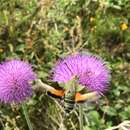Conservation Status
University of Alberta Museums tarafından sağlandı
This is a rarely encountered species, at the northern edge of its range in Alberta
- lisans
- cc-by-nc
- telif hakkı
- University of Alberta Museums
Cyclicity
University of Alberta Museums tarafından sağlandı
Adults have been collected in Alberta from late May to July.
- lisans
- cc-by-nc
- telif hakkı
- University of Alberta Museums
Distribution
University of Alberta Museums tarafından sağlandı
Juanita ranges from the grasslands of southern Manitoba, Saskatchewan and Alberta south across the Great Plains to northern Mexico. In Alberta, it has been collected in the Grasslands region, in the Lethbridge and Drumheller areas.
- lisans
- cc-by-nc
- telif hakkı
- University of Alberta Museums
General Description
University of Alberta Museums tarafından sağlandı
A medium to large-size (4.5-6.0 cm wingspan) narrow-winged diurnal moth. The forewings are light yellow-brown or greenish-brown, crossed by a wide dark brown median band, bordered on the outside edge by a light orange band, which in turn blends into a dark terminal border. The hindwings are orange bordered with black. The body is light yellow-brown.
- lisans
- cc-by-nc
- telif hakkı
- University of Alberta Museums
Habitat
University of Alberta Museums tarafından sağlandı
Prairie roadsides and meadows.
- lisans
- cc-by-nc
- telif hakkı
- University of Alberta Museums
Life Cycle
University of Alberta Museums tarafından sağlandı
Juanita is another small colorful day-flying sphinx moth that may be found nectaring at flowers. Unlike most sphingid larvae, those of juanita lack an anal "horn". There is a single brood each year.
- lisans
- cc-by-nc
- telif hakkı
- University of Alberta Museums
Trophic Strategy
University of Alberta Museums tarafından sağlandı
No Alberta data; elsewhere reported larval hosts include Evening Primrose (Oenothera sp.) and Willowherb (Epilobium sp.).
- lisans
- cc-by-nc
- telif hakkı
- University of Alberta Museums

